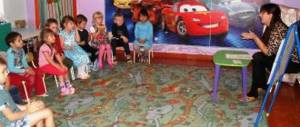Conversation “Talk about proper nutrition.”
N.N. Provotorova
Topic: Talk about proper nutrition (conversation)
Goal: study and systematize knowledge about rational nutrition, consider this information from various points of view and comprehend it from a scientific point of view; stimulation of cognitive activity of students; nurturing a culture of communication and the ability to defend one’s point of view with reason.
Characters: nutritionist, physiologist, culinary specialist, experts, “chip eater”, “meat eater”, vegetarian, “sweet tooth”.
C script
Educator: Everyone knows the ancient saying “We eat to live, but we do not live to eat.” Proper (rational) nutrition is one of the most important conditions for existence, normal functioning of the human body, strength and health. His performance and longevity depend on how a person eats. In the process of life, there is a constant expenditure of energy to carry out physiological functions, biochemical processes in the body, and perform certain work. These energy expenditures must be replenished in a timely manner through the food consumed. In order for it to bring maximum benefit, it is necessary to have a scientifically based understanding of the value of the constituent elements of products, methods and means of their culinary processing.
In front of me are the questionnaires that I invited you to fill out. They contain two questions:
"Chipseater" . I think the best food is chips and soda, and a pizza and a hamburger would be nice, topped off with a Snickers.
Nutritionist. The food that the first guest offered us is called “garbage” food. You will ask why? The answer is very simple. Let's look at the information provided on the packaging of some food products.
(reads the product ingredients labels on the packages)
In addition to dairy and cocoa products, a chocolate bar contains: an emulsifier, a flavor (usually identical to natural), and a preservative. In potato chips and crackers, except potato and rye-wheat: a flavoring and aromatic additive, again identical to the natural one, a flavor and aroma enhancer. In carbonated drinks, in addition to water and sugar: saccharin and cyclomate - sugar substitutes, phosphoric acid, dyes, synthetic essences, sodium benzoate, carbon dioxide.
All these substances are to some extent harmful to our body. For example, in a number of countries, saccharin and cyclomate are completely prohibited, since expert opinions about their harmlessness differ. But sodium benzoate can cause intolerance in particularly sensitive people - urticaria, asthma and even anaphylactic shock; it is also a carcinogen and with prolonged exposure can cause cancer.
When food rich in carbohydrates (chips) is processed at high temperatures, a large number of harmful chemical compounds are formed. Which cause cancer, can affect the nervous system and lead to infertility.
Why is such food called “junk”? Scientists have established that “fast food” products clog our body with unnecessary substances, which cause many diseases, and, as we know, slag is garbage. In addition, fast food products are addictive, like a drug, as a result of an imbalance of hormones responsible for the feeling of satiety.
All of these products can be replaced to benefit your business. What do you think can be replaced?
(children's answers)
"Sweet tooth." It’s clear that you can’t eat chips for lunch. I’m unhappy that they don’t give us cakes, sweets and any other sweets in the canteen. After all, sweets increase brain performance, which is very useful for us. Is this very expensive?
Nutritionist. It's not about the price at all. The assortment of dishes for breakfast, lunch and dinner is selected based on the nutritional value of the products, their content of essential nutrients and calorie content. Let's talk about caloric content of food.
A person’s need for a certain amount of calories per day depends on age, gender, nature of work and place of residence. Experts have developed the body's approximate calorie needs. For boys 8-9 years old it is 2000 kcal, and for girls of this age - 1500 kcal per day.
Let's imagine that, based on the wishes of those with a sweet tooth, we will eat one honey-chocolate cake for breakfast, which is 610 kcal, wash it down with fruit jelly, and add another 152 kcal.
The total calorie content of this breakfast is 762 kcal.
Lunch: dried apricot soufflé - 414 kcal, two cheesecakes with cottage cheese - 882 kcal, cherry juice - 199 kcal.
Total: 1495 kcal.
Afternoon snack: sugar cookies (200 g) - 804 kcal, yogurt (100 g) - 85 kcal.
Total: 889 kcal.
Dinner: apple pie (200 g) - 764 kcal, apricot juice - 102 kcal.
Total: 866 kcal.
The total number of kilocalories received per day will be 4012 kcal, which exceeds the norm for boys by 1012 kcal. And for girls it’s 1412 kcal.
It is not difficult to imagine what awaits us with such nutrition.
Let me give you a few examples. In order to use up the energy received by the body after eating a sandwich with cheese without butter, which is only 150 kcal, you need to exercise for one hour. A cutlet with potatoes 725 kcal is “cancelled” by walking 20 km, ice cream by clearing snow for one hour, a piece of cake 290 kcal by cleaning the apartment for an hour and a half.
Meat eater. It is clear that all these buns and cakes only contribute to the deposition of fat, and they are of little use. Need more meat dishes. A couple of sausages can't feed us. We grow, and we need animal protein to grow. Without this you won't build muscle. Besides, what could be easier to prepare than a piece of fried meat?
Physiologist. And you know the future of people who mindlessly build muscles. As soon as they reduce the load, muscle tissue degenerates into connective fat, and obesity develops. In addition, eating only animal proteins disables the liver and pancreas. In the Middle Ages, they even used such torture: a person condemned to death was fed only meat. The body was poisoned and painful death occurred.
Did you know that a tractor driver, whose work requires a lot of physical effort, needs only 200 kcal of meat per day? The same ones. And it doesn’t work physically, excess protein will only increase the formation of toxins, which settle in the vessels and joints, and lead to the development of various arthrosis and other diseases. I advise you to often replace meat in the menu with fish - it is more easily absorbed by the body and contains a sufficient amount of proteins. Peas, beans, milk, cottage cheese are rich in proteins - these products are just as necessary and can replace meat and fish.
Vegetarian. The healthiest food is vegetables. We must give up meat foods and sweets, since they are so harmful. I also heard that people deprived of fresh fruits and vegetables can get scurvy. Why?
To ulinar. I will answer this question. It is impossible to keep plant materials fresh for a long time. And during culinary processing, some of the vitamins are lost. Remember simple rules to reduce vitamin loss:
*use tools and devices made of non-oxidizing metals;
*for cooking and storage, use enamel, glass or ceramic dishes;
*When cooking vegetables and fruits, place them in boiling water, the level of which should be 1 -1.5 cm above the filling;
*When cooking, cover the container tightly with a lid;
*Boil vegetables for vinaigrette in their skins.
But as for eating plant foods, I want to say that a sudden increase in protein in food negatively affects brain function and weakens the body’s protective properties. A growing person especially suffers from a lack of proteins, because protein is a building material for cells. And carbohydrates are the main source of energy necessary to maintain life. Fats that make up cells also contribute to resistance to diseases and adverse environmental factors. Many, trying to lose weight, do not eat porridge, butter, skip dinner, and try to starve. This is ruthless and even criminal towards your own body. You can fast only if necessary and under the guidance of a specialist.
Experts. After listening to different points of view, we came to the conclusion that both undernutrition and overeating have a negative effect on the human body. Hence the conclusion - nutrition must be correct, scientifically based, rational. A healthy person should not exclude anything from his menu; food should be tasty and varied.
But everything needs moderation. It is necessary to consume foods taking into account their energy value and the body's needs.
You should also follow your diet. I didn’t have breakfast in the morning, I ate too much at lunch, at dinner, went to bed with a full stomach, and ended up with a headache. Remember the famous aphorism: “Eat breakfast yourself, share lunch with a friend, give dinner to your enemy.”
It is very important to know the rules of cooking, which allow you to make it not only tasty, but also healthy.
“Normal and healthy food is eaten with appetite, food is experienced with pleasure,” said academician I.P. Pavlov. Monotonous food quickly becomes boring, and this reduces appetite and digestibility of food products. It is necessary to take care of the variety of the menu, the correct culinary processing of food, as well as the environment in which it is eaten.
And may food always bring you pleasure and benefit!
.
Show off all the variety of products
By liking fruits and vegetables at a young age, children will continue to develop these food preferences, which will help reduce the risk of developing diabetes, heart disease and cancer later in life. Little picky eaters go through a very natural stage of development, exercising control over everything around them and expressing distrust of the unfamiliar. So, instead of forcing your toddler to try something new and unfamiliar to him, try the following:
- Offer a new portion of food only when the child is hungry
- Offer only one new food per meal
- Combine new foods with favorites to make them easier for your child to accept.
More positive : turn mealtime into a game in which the child can become, for example, a famous chef, who can give his review of the dish that he had to try. This is much more interesting than just talking to children about proper nutrition.
Go shopping with your children: let them see a variety of fruits and vegetables for themselves and choose something new that they would like to try.
Lead a healthy lifestyle yourself: children always inherit the behavior of adults, so it is necessary that your behavior is the right example for them. Agree, we cannot ask children to eat vegetables and fruits if we ourselves lean on chips and carbonated drinks.
Conversation “Vitamins strengthen the body”
Target:
- introduce the concept of “vitamins”;
- consolidate knowledge about the need for vitamins in the human body, about healthy foods that contain vitamins;
- to cultivate in children a culture of nutrition and a sense of proportion.
Educator: Guys, today a boy Vanya Zaboleikin came to visit our group. (the teacher brings a boy from a neighboring group) Meet him, guys, say hello. (children meet Vanya)
Educator: Vanechka, you’re such a good boy, but for some reason your last name is kind of strange—Zaboleikin?
Vanya: And I like my last name, because I like to be sick all the time. I came today, but tomorrow I’ll get sick and sit at home. Then I’ll come back for a day and get sick again...
Educator: Well, Vanya, something incomprehensible is happening to you. Do you really like sitting at home, missing out on interesting classes where kids become smart and knowledgeable? And in general, it’s boring to sit at home, there’s no one to play with!
Educator: Guys, do you like to get sick? (No!)
Educator: Guys, please tell me what needs to be done in order to stay healthy? (children's answers)
Educator: Indeed, sometimes it happens that children get sick, but we must try to be healthy. If you want to be healthy, remember one secret.
Vanya: What's the secret?
Educator: If you want to be cheerful, efficient, strong, if you want to fight infectious microbes, and not succumb to any diseases, take vitamins every day.
Vanya: What are vitamins? (asks)
Educator: Sit down, Vanechka, next to the children. Today we know what vitamins are.
Vitamins are substances that our body needs to absorb food, they increase performance, resistance to infectious diseases, and promote the growth of our body. If there are not enough vitamins in food, then a person suffers from various diseases, becomes lethargic, sad...
Educator: Do you want to know where vitamins come from?
Educator: And our senior nurse Svetlana Stepanovna will tell you about this.
Nurse: Hello, children!
Children: Svetlana Stepanovna, we want to interview you.
Children: Please tell me where do vitamins come from?
There are a large number of bacteria lurking in the soil. Microbes are the most common inhabitants of the Earth. They exist everywhere: in the air, in the soil, in the water... Many of these tiny creatures begin to produce vitamins, enriching the soil and air with them. In nature, vitamins are formed in plants, so fruits, vegetables, and fruits serve as the main source of vitamins for people in the body. Every blade of grass, every leaf catches the sun's rays - the source of life. A ray of sunlight will fall on a green leaf and go out, but will not disappear; with its help, substances for the plant will appear in the leaf, and vitamins will also appear. They are usually designated by letters: A, B, C, D, PP, E, K
Children: What foods do vitamins “live” in?
Nurse: I brought you a diagram by which we will find out which foods contain the most vitamin. (scheme under consideration)
— The amount of vitamins entering our body with food depends on the time of year. Guys, what time of year do you think we get the most vitamins? (Summer, autumn)
— That’s right, in summer and autumn there are more of them in food products, so in winter and spring you need to buy them at the pharmacy. They need to be consumed in certain doses (1-2 tablets per day)
And I have prepared a surprise for you today. These are living vitamins - fruits!
Educator: Thank you Svetlana Stepanovna.
Educator: Now look and tell me what can be made from fruits? (children's answers)
Educator: Well done! That's right, you can prepare a sweet salad and season it with yogurt.
Sweet salad.
Products:
· Banana – 2 pcs.
· Mandarin - 2 pcs.
· Pear - 2 pcs.
· Apple - 2 pcs.
Peel the banana and cut into slices. Cut the pear into cubes, and peel the tangerine from the peel and veins, then carefully divide it into slices! (Salad is prepared under the guidance of the teacher)
Place the assorted fruits in a deep bowl and season with yogurt, then mix everything thoroughly.
- Our sweet salad is ready!
Educator: And now the guys and I invite Vanya Zaboleikin to the table. (Tasting salad)
Vanya: That’s great, thank you! (Zaboleikin rejoices) It turns out that no matter what product you take, each contains vitamins. I’ll go home, ask my mother to cook buckwheat porridge with milk, make a rosehip infusion, grate raw carrots - and I’ll have a whole set of vitamins in my body. Now I have solved the riddle of why I get sick all the time. I thought that all soups, all cereals, milk, onions, garlic are all tasteless products, and I asked my mother to buy me candy, chips... I didn’t know that there were healthy and necessary products. Now I will be literate, I will go to kindergarten every day, your doctors know exactly what healthy menu to offer children, and I will be strong and healthy. (leaves)
Educator: We worked well with you today. What did you like most? What do you remember? What new did you learn?
You all did your best today, well done, thank you!
Scheme:
What foods do vitamins “live” in?
| Vitamin | Where does he live? | What is it useful for? |
| Vitamin A" | In fish, liver, apricots | Skin, vision |
| Vitamin "B1" | In rice, vegetables, poultry | Nervous system, memory, digestion |
| Vitamin B2 | In milk, eggs, broccoli | Hair, nails, nervous system, |
| Vitamin "PP" | In bread, fish, vegetables, meat | Blood circulation and blood vessels |
| Vitamin B6 | In egg yolk, beans | Nervous system, liver |
| Vitamin B12 | In meat, cheese, seafood | Growth, nervous system |
| Vitamin C" | In rose hips, sea buckthorn | Immune system, wound healing |
| Vitamin D" | In liver, fish, caviar, eggs | Bones, teeth |
| Vitamin "E" | In nuts, plant. oil | Sexual and endocrine glands |
| Vitamin "K" | In spinach, zucchini. cabbage | Blood clotting |
| Pantheic acid | In beans, color cabbage, meat | Motor function of the intestine |
| Folic acid | In spinach, green peas | Growth and hematopoiesis |
How to convince your child to eat more vegetables and fruits
Proper nutrition for young children must include fruits and vegetables. Here are some fun ways to add more fruits and vegetables to your toddler's diet: offer your child a colorful fruit mix as a snack between meals, add vegetables or fruits for baking - pumpkin bread, blueberry muffins, etc. And the attractive appearance of the dish will increase the child’s desire to try it. For example, you can create an edible collage: use broccoli for the tree, tomatoes and beets for the flowers, and cauliflower and carrots for the clouds and sun. Enjoy your masterpiece!
Limit sugary foods and drinks
A small amount of sugar added to foods is not harmful. On the contrary, a spoonful of sugar added to whole grain porridge will improve its taste and increase the child’s desire to eat it. However, it's a different story with the sugary sodas—rich only in calories, not nutrients—that kids love. Therefore, limiting sugar in children's diets is one of the most difficult challenges for parents. Resist the temptation to ban candy completely and immediately, as such a taboo will only encourage children to overeat sweets as soon as they get the chance.
The transition to a healthy diet should not be difficult for little ones with a sweet tooth: if they cannot refuse, for example, ice cream, then freeze a banana cut into pieces, and then beat it in a blender with the addition of cocoa or natural chocolate - this way the child will get the desired ice cream, and you - peace of mind for your health. Try giving your favorite sweet recipes a second chance—many recipes taste just as good with less sugar. However, try to limit the consumption of processed foods such as cakes and cakes as they cause spikes in blood sugar levels, which will result in your child getting tired and losing energy.
Fat control
Fats, of course, must be present in a child’s diet. They are necessary for the construction of cell membranes, the synthesis of certain hormones, and also promote the absorption of fat-soluble vitamins (A.E.K. vitamins of group D). Therefore, fats are involved in the prevention of many diseases - for example, rickets, blurred vision, and the like. In general, fats can be classified as saturated (solid at room temperature) and unsaturated (liquid). Both groups are important and are present in children's daily diet. Solid fats are predominantly of animal origin, while liquid fats are of vegetable origin.
Liquid fats are considered easier for the body to absorb, so they should be given preference in a child’s diet. Although consuming small amounts of fat is important for a healthy diet, many children today are overindulging in fatty foods, in particular chips and crackers, in which up to 50% of the total fat mass can be chemically altered (so-called trans fats), and are harmful even for the adult body. It is known that trans fats can provoke the development of certain cancers. A source of saturated fat and cholesterol in a child's diet is also fatty meat, in particular when it is fried in a large amount of oil. Therefore, it is better to offer children low-fat fermented milk products, choose lean meats and, of course, do not forget that the benefits of the product also depend on the method of its preparation.
Move towards your goal together
It is very important that babies' food associations are positive. Therefore, sit down to the table with the whole family : the child’s habit of sitting down at the table at approximately the same time, when all family members gather together, causes a feeling of comfort and helps increase appetite. If your child wants to help you prepare food, then do not deny him the opportunity to spend time together, especially since a dish to which he puts his own efforts will always go better. And in your free time, it is advisable to involve children in active leisure: do morning exercises with the children, go for walks, organize small sports competitions - this will not only help maintain the child’s normal weight, but also create your own family traditions.
Even for us adults, it’s not always easy to switch to a healthy diet, what can we say about children? On their own, they are unlikely to undertake to re-read scientific lectures about the benefits of natural products for the body and draw any conclusions, and they do not need this, because they are children who live by emotions and impressions. That is why, one of the main tasks of parents is to make healthy foods attractive to children, through a varied diet, good-looking prepared dishes, creating play situations and, of course, using their own example of a healthy lifestyle.





